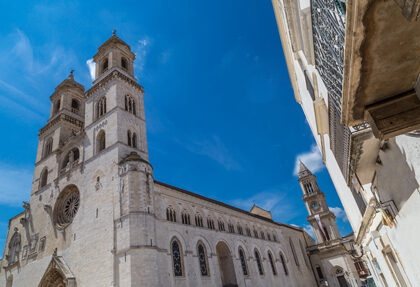La chiamano la Leonessa di Puglia: stiamo parlando di Altamura, città fiera e ribelle, bella e nobile per la sua storia e cultura. Siamo a poco più di 40 km da Bari e a 19 km da Matera. Questa è Altamura, città di storia e dal passato illustre. Il nome ricorda la mitica regina Altea, e nel passato prese anche il nome di Altilia, fiorente città dell’antica Peucezia. La presenza dell’uomo, ad Altamura, è antichissima. Ne sono una prova, ad esempio, i resti dell’ uomo di Altamura, scoperti nel 1993 nella grotta di Lamalunga, appartenuti a un Neanderthal vissuto all’incirca 150.000 anni fa, oltre che i numerosi reperti recuperati negli scavi archeologici del territorio, molti dei quali conservati presso il Museo Nazionale Archeologico di Altamura.
It is called the Leonessa di Puglia: it’ s Altamura, a proud and rebellious city, beautiful and noble thanks to its history and culture. We are just over 40 km from Bari and 19 km from Matera. Altamura, a city of history and illustrious past. The name recalls the legendary Queen Altea, and in the past was also called Altilia, a thriving city of ancient Peucezia. The presence of humans in Altamura, is very old. Proof of this are, for example, the remains of the Altamura man, discovered in 1993 in the cave of Lamalunga, which once belonged to a Neanderthal who lived about 150,000 years ago, as well as the numerous finds recovered from archaeological excavations in the area, many of which are kept at the National Archaeological Museum of Altamura.






